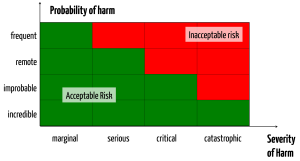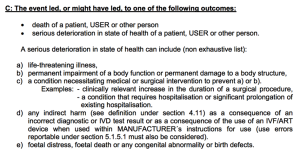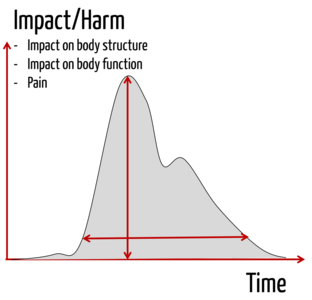Harm and Severity
Severity of damage in accordance to ISO 14971
The ISO 14971, the standard for risk management for medical devices, defines the term severity (damage) as a "measure of the potential impact of a hazard".
Quantify and classify severity of damage
The risk acceptance matrix serves manufacturers in assessing the risks based on the probability and severity of damage. This assumes that probabilities and severities are thus divisible and able to be ever quantified in classes.

The challenge facing many medical products manufacturers, is that it is not easy to quantify the severity of damage. It requires a sharp classification feature to precisely classify damage so it is reproducible for a severity.
Examples of classification characteristics of damage
- Death (y / n)
- Hospitalisation > n days (y / n)
- Degree of disability > XY% (y / n)
- Intensive care (for non-ICU patients) required (y / n)
- medical intervention necessary (y / n)
- reversible (y / n)
- Shortening of life expectancy > X months (y / n)
- Shortening of life expectancy> x% compared to the life rating at "proper treatment"
- Pain level> X
- Quality of life, mental distress pursuant to "Quality of Life" criteria
When studying the MEDDEV 2:12. I came across a definition of serious damage:

It might help in formulating the severity of your classes.
Another classification of (short-term) damages can be found in Wikipedia (NACA score). This classification originates from the National Advisory Committee for Aeronautics - originally developed for the classification of accidents in aviation.
Severity of damage: challenges in the evaluation
The evaluation of this severity is difficult:
- What's worse, the patient whose knee is permanently stiff by the failure of a medical device, or the patient who was in a life-threatening situation, for a short amount of time, that was solved only thanks to the intensive care physician without any consequential damages?
- Are the two months that a terminally ill person, who has only six months left to live, worse or better than the two months that the person who has another 10 years?

Many scores only consider the severity of acute injuries. A non-life-threatening but non reversible damage such as a permanent disability can be classified as not good in this scheme. So this does not help us in the ethical debate about whether one should use the maximum short-term effect ("the level of the injury curve"), or instead the duration of the effect, or rather the "Integral" of this curve in the damage.
Tips for defining the severity classes
- Many people may fail one of risk managements first hurdles - creating the risk acceptance matrix. Already their severity class is classified as incomplete. So I often only find attributes such as "light", "serious", "hard" and "catastrophic". But how a "serious" damage is defined, is missing in the risk management file.
- You can complete the definition as a manufacturer of heavy-grade classes by concrete examples in your medical device. Then it will be easier during the risk analysis (in compliance with ISO 14971), to estimate how high the severity of the damages that can be caused by your medical device will be.
- In risk management medical device manufacturers often make the mistake of setting severity classes such as "potentially lethal" or "carries a risk of life-threatening injury". That's not correct, because the probability is not included in the definition of the severity classes of damage. The probability axis is independent, especially if the risk is already defined as a combination of probability and severity.
- Avoid in-depth ethical discussions on the severity of damage: Are two injured people worse than a dead man?
- Make sure that you fully define the severity of damage. So, for example, several "serious irreversible injuries" "for more than one person."
In the auditgarant you will learn step by step, and very concretely, how you can define the severity of damage in your risk assessment matrix. You can check on the basis of several examples, if you can identify and correct faulty definitions.


